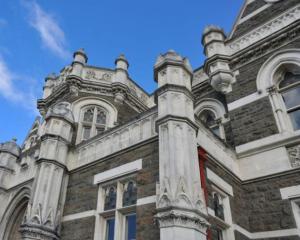The prospect of turbines being raised on his doorstep "horrified'' one of the neighbours of a proposed Blueskin Bay wind farm project, which has polarised the community.
Simon Ryan and his wife Jennifer Ashby's residence will be the closest house to the turbines.
Speaking yesterday during the second day of the resource consent hearing for Blueskin Resilient Communities Trust's (BRCT) $5million to $6million proposal to build three wind turbines on Porteous Hill, north of Dunedin, Mr Ryan said when he first caught wind of the proposal he was "horrified'' by the potential noise and wind pressure that the project might create.
"I have many friends in Austria and Germany who view these things in horror now that the reality has been realised,'' he said.
Mr Ryan and Mrs Ashby's house would be less than 500m from the nearest turbine, if the application is granted.
He had spent time in northern Europe and the perception of wind farms had shifted there. Residents now had concerns about their effects, especially unknown health effects, he said.
"Benefits are, at the least, uncertain,'' he said.
"We therefore generally agree with [Dunedin City Council planner] Mr [Darryl] Sycamore that little weight can be given to any positive effects arising from the community directly benefiting from the proposal.
"We are not certain what is being proposed and where. We are also not certain how controls on issues like turbine height and placement are to be incorporated into consent conditions. This needs to be rectified.
"At present, we can have no certainty regarding the level of effects on us in relation to key issues or on the veracity of the applicants' evidence.''
His submission, which was presented in unity with fellow neighbours Lyndon and Kirsty Clayton, whose house is less than 700m from the closest proposed turbine, said the wind farm would negatively impact their visual amenity, quality of life and the natural landscape.
The neighbours presented two expert witnesses - landscape architect Stephen Brown and ecologist Dr Rachel McClellan - who also made submissions opposed to the proposal.
BRCT proposes placing three 90m tall turbines on Porteous Hill to return the profits, estimated at $100,000 annually, to community causes and needs.
The trust claimed in its submission it had widespread community support for the venture.
However, the Claytons and Mr Ryan and Mrs Ashby denied the claim and said those most affected by the project were the most opposed to it being installed.
"We have experienced a sense of frustration and indignation at the claim made for widespread community support by [BRCT],'' Mr Ryan said.
Mr Clayton said the proposal would also have an unknown effect of his farming operation and could render some of his property unproductive because of no-fly zones around turbines which would prevent him from fertilising hilly sections by helicopter.
Mr Brown submitted the natural landscape would be diminished by the project and "the proposal would erode much of the scenic value'' of the area.
Dr McClellan said the impact on wildlife, particularly birdlife, was unknown, as data was lacking.
The few studies which had been performed had vastly disparate findings, she said.
Another landscape architect, Jeremy Head, made a submission in opposition on behalf of other nearby residents.
"I find it troubling that an inappropriate place for wind turbines is relegated to because it's easy to build them there,'' he said.
Their installation would result in significant earthworks, scarring of the hillside and displaced vegetation, he said.
"In my opinion, the silhouette of Porteous Hill would be dramatically changed.''
Several other residents made submissions in opposition to the proposal because of its visual impacts, noise, fears for birdlife and uncertain economic returns.
Green Party co-leader Metiria Turei, a Waitati resident, said she was fully supportive of the proposal.
"This is not a corporate entity bringing to you a major commercial development, it's a community organisation with many years' community service,'' she said during her submission.
"I see this application being very ambitious, but a natural extension of that community service.''
The proposal would change the visual landscape, but in a positive way, and would reflect the changing attitude of the community itself, she said.
"The out-of-sight, think-big approach to energy generation belongs in the 20th century, not in the 21st century,'' she said.
"In the 21st century we take responsibility for our community's needs.
"If we are going to have a future that will survive through the impacts of climate change, this is exactly what we want to see happening in our natural environment.''
Jen Rodgers, another Waitati resident, submitted in favour of the proposal, as did action group Generation Zero and several other Dunedin residents.
Commissioner Colin Weatherall said the hearing was expected to continue late into today and a decision remained weeks away.
"I'm not going to promise you an answer next week. I'm saying it's weeks instead of days,'' he told neighbours of the proposed site.
"It's not going to be a quick answer and I don't apologise for that. If I'm going to give you a quality answer, I have to take some time to do so.''
Council planner Darryl Sycamore will present his recommendations today and the trust will be given its right of reply.
Mr Sycamore originally recommended approving the proposal, but retracted that recommendation on Tuesday after changes were made to the proposal. He reserved his findings until submissions were heard.
The issue
Blueskin Resilient Communities Trust's proposed wind farm.
•Three 90m turbines to be built on Porteous Hill, near Blueskin Bay.
•The power generated by the turbines would be sold and profits returned to the community.146 submissions received by the Dunedin City Council - 73 in support, 68 opposed and five neutral.
•The closest neighbours to the site are adamantly opposed.
•Conflicting submissions heard from five separate landscape architects.
•Ecologists are also divided about the potential impact on native wildlife.
•The proposal has divided the community.












